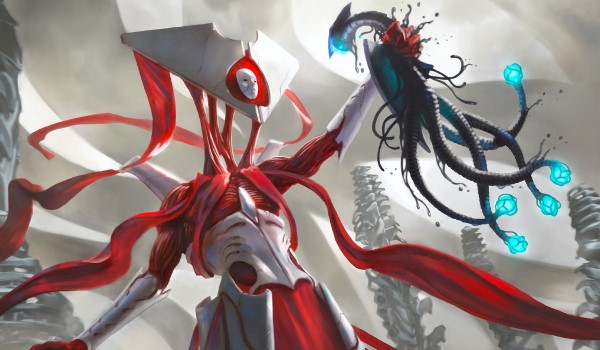Are you a Quiet Speculation member?
If not, now is a perfect time to join up! Our powerful tools, breaking-news analysis, and exclusive Discord channel will make sure you stay up to date and ahead of the curve.
In the first weeks of Phyrexia: All Will Be One (ONE), we identified red and white as the best colors. Green, black, and blue followed, in approximately that order. The format was labeled one of the most aggressive of all time, and if you didn't have a play by turn two, you were probably losing. None of this has changed.
On a smaller level, however, things seem to be evolving. Last week's article on blue was a reaction to that. Once the color was labeled untouchable, we recognized we could cherry-pick its best cards. However, with less eyes on blue, Naya is getting crowded. In the early weeks of the format, we just wanted to be red and white. Toxic, oil, artifacts, whatever. Red decks got copies of Hexgold Slash and Chimney Rabble on the wheel. White decks had access to so many aggressive cards that toxic felt like just a bonus. Now, these colors are more contested. Which means Naya drafters (and most of the time, we should be Naya drafters) will have a tougher time.
Game Plan for Naya
The recipe for success in the early days of ONE was simple. Just be red and/or white. This deck wanted to be toxic enough to enable its corrupted synergies, but it didn't really have the means to win through toxic. This is an old-fashioned aggro deck.
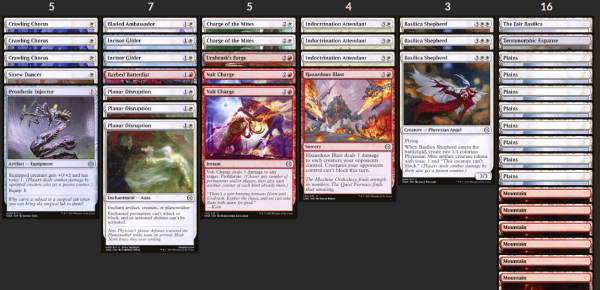
7-1 RW Aggro
Despite the number of toxic creatures in this deck, and my affinity for Prosthetic Injector in the early stages of the format, this deck isn't really a Toxic deck. It was toxic enough to enable corrupted, but hardly had a chance at getting opponents to ten poison. More often than not, the Basilica Shepherds hit like the Phantom Monsters they are and attacked for lethal.
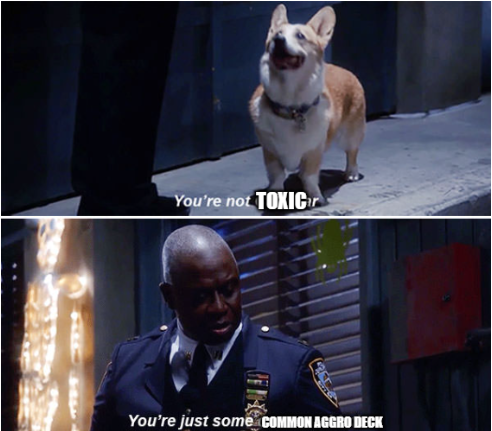
If we can still pile up strong red and white cards, we should. However, it's less likely that this option will be available to us now that the format has adapted to the disproportionate strength of Naya. If Naya decks are going to evolve, they need to maximize the synergies of the scripted archetypes.
Naya in the New World
In a world where we can't get expect to see pack after pack of powerful cards in red, white, and green, we need to get more out of the synergy cards. Goldwarden's Helm and Bladegraft Aspirant are cards I wasn't interested in during the early weeks of the format. Now we should look to pick them up if we're heading into the RW equipment deck.
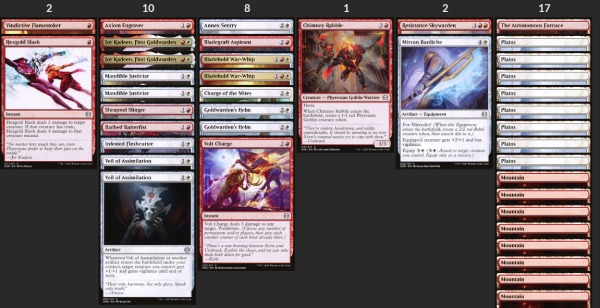
7-1 RW For Mirrodin
Veil of Assimilation was a card that looked like a dud to me. The card is too reliant on synergies and didn't impact the board. In this deck, the card was a house.
If it looks like we're going to lean into an artifact subtheme, we can make those mediocre three drops better. While we should still snag a late Chimney Rabble or Hexgold Slash if we see it, the flow of red cards has slowed to a trickle. Don't be afraid to lean into those synergy cards early. Optimizing our presence in a specific archetype, specifically the red and white ones, should be a priority.
Big Oil vs. Oil Slick Aggro
RG Oil is probably still the best deck in the format when it comes together (RW Equipment and White Toxic are also in the discussion). However, the best RG Oil decks rely on premium cards up and down the curve.
We want some amount of one-drops, all of which are good to great. We want Axiom Engraver and Barbed Batterfist, some of the best two-drops in the format. At three, we're hoping for a Contagious Vorrac, but we're willing to settle. Then we top our curve with premium options at four and five. Furnace Strider, Lattice-Blade Mantis, Oil-Gorger Troll, and Chimney Rabble are all excellent.
That deck is basically a composite of the format's best commons. When we mix in the premium removal, and maybe the best uncommon in the set in Cinderslash Ravager, there's no question as to why this deck performed so well. Big Oil is a juggernaut, but is it sustainable?
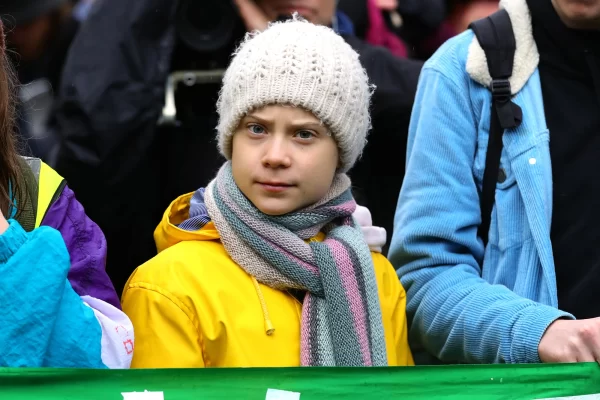
As we react to restricted availability, we need to rely on synergy. Free From Flesh always felt like a bad Blazing Crescendo, but the most aggressive decks might prefer the one-mana trick. Using it precombat to boost a Kuldotha Cackler or to pre-pay for the Forgehammer Centurion trigger can accelerate the oil decks. While Big Oil is still better, Oil Slick is a potent off-ramp for many of the strong red cards, especially the multiple one-drops.
We're not seeing an endless string of powerful red cards these days. We need to know when our red decks should pivot into an even more aggressive build. This audible can salvage a mediocre RG pile and lead us into the kind of lean, aggressive deck that thrives in this format.
You Come to a Fork in the Road
White has three strong common two-drops. In a perfect world, we know what our deck is going to look like before we have to make this decision.
Clearly, Mandible Justiciar performs better in artifact decks, whereas Duelist of Deep Faith is an option for toxic decks. Incisor Glider is great if we can reliably corrupt our opponents, but early in the draft, this card is a distant third choice.
Mandible Justiciar has a slightly better GIH WR% and OH WR%. Every deck in this format wants to gain life. Still, between the two, we should prioritize the Duelist. Certainly, both cards have decks they'll be good in. But knowing the importance of premium two-drops in toxic decks makes this card a more valuable early pick. While we're willing to include both creatures in either deck, not having good toxic two-drops in an otherwise strong Toxic deck is a disaster.
While Mandible Justiciar might be a better card, I'm not sure that it is a more valuable one. The toxic decks need to get through that toxic damage early. The first few hits are the most important, and Duelist of Deep Faith is more than up to the task.
Better vs. More Valuable
By most metrics, Annex Sentry is the best uncommon in the set. It has synergies with toxic and artifacts, white's two overlapping themes. It's a Fiend hunter in what's arguably the format's best color. And it boasts the highest GIH WR% and highest IWD% according to 17lands.
However, I'm not sure that it's the most valuable. Cinderslash Ravager has a strong claim to this throne, as does Bladehold War-Whip. Both are incredibly powerful cards that elevate their archetypes, but being gold comes with limitations.
In sports, they often award the MVP based on narratives and other unclear criteria. What constitutes value? And to whom must this card be valuable? With that being said, I'd like to debut an extremely unpopular opinion:
Bilious Skulldweller is the format's most valuable uncommon.
While we shouldn't take this card over Annex Sentry, it provides an unmatched opportunity for a strategy (admittedly a weak one) to exert its gameplan. Skulldweller allows Black Toxic to get their first poison damage in the early stages of the game. Unlike White Toxic, black decks rely on proliferate, and don't have the likes of Flensing Raptor, Crawling Chorus, or Duelist of Deep Faith to keep the pressure up. Black's next best applicant for this job is Pestilent Syphoner, which could be described as a necessary evil. In truth, the diminutive flyer is better classified as a liability.
Bilious Skulldweller unlocks an entire color in a way no other uncommon does. That is my reasoning for crowning this unassuming critter, despite its admittedly dubious 17lands stats.
Why "Valuable" Matters
Regardless of how you feel about Billious Skulldweller, as we look towards synergies, we should factor the value of a card over its raw power. This is not a new concept, but as this format matures, it becomes more important to view things through this lens. While last week we talked about cherry-picking blue, the Naya colors are ransacked by the middle of the pack. Therefore, as we select cards lower on our tier lists, we need to make sure we're creating a shell that can optimize our 20th-23rd inclusions.
As we're drafting, that means asking ourselves, "what does this deck do?" and "what does this card do for my deck?" These questions help us build more synergistic decks and prioritize how cards will support our overarching gameplan, especially as we find homes in contested colors. Yes, sometimes the draft will offer us untold riches and a clear path through two colors, but more often than not we're going to have to put forethought into our picks to end up in a strong position.
This is why we should take Duelist of Deep Faith over Mandible Justiciar early on. Conversely, we still shouldn't take Free From Flesh over Blazing Crescendo. While the one-mana trick might be better in some versions of the oil deck, it's unlikely to overpower the free card from Blazing Crescendo on average. Value and power might fluctuate in the eyes of a given drafter, but as our colors become more contested, small synergistic choices can mean the difference between flopping and trophying.


